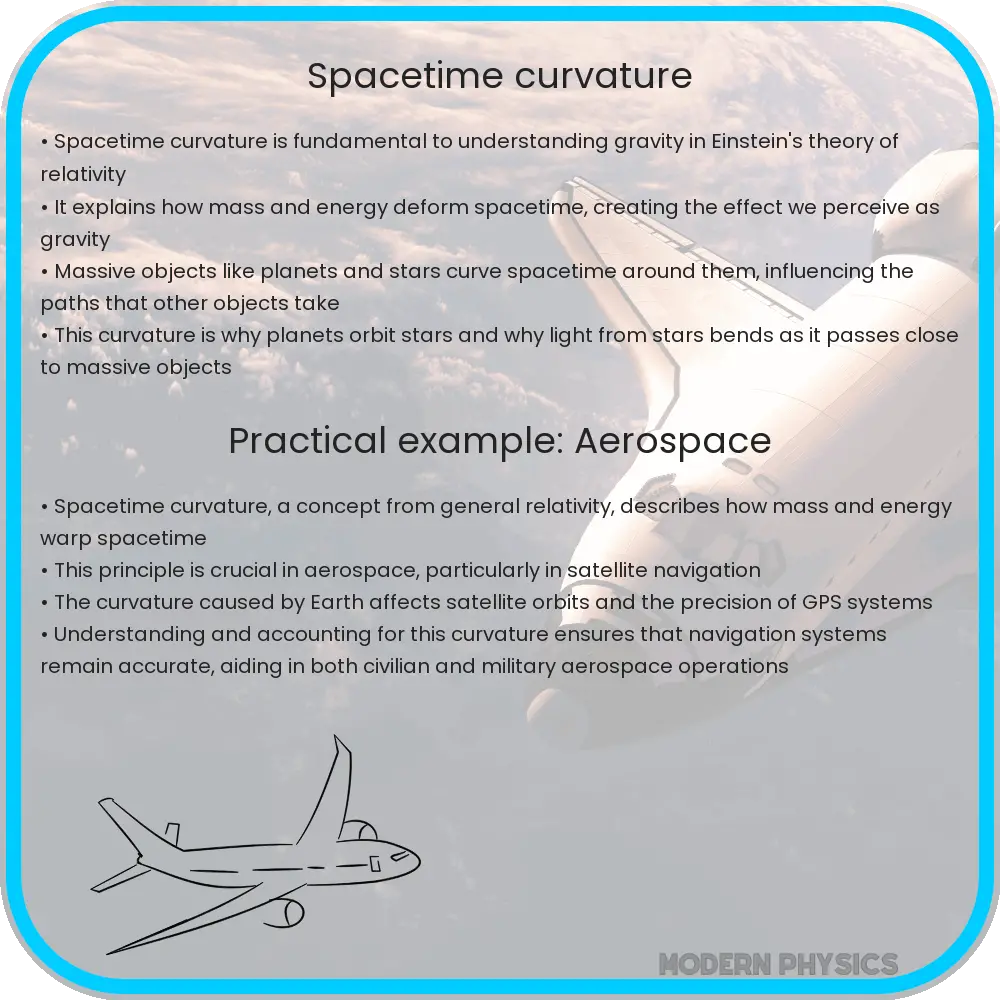Explore the essence, effects, and applications of spacetime curvature in General Relativity, from black holes to GPS technology and cosmology.

Understanding Spacetime Curvature in General Relativity
Spacetime curvature is a fundamental concept in Albert Einstein’s theory of General Relativity, revolutionizing our understanding of gravity and the universe. At its core, General Relativity posits that gravity is not a force exerted through space, but rather a manifestation of the curvature of spacetime caused by mass and energy. This curvature guides the motion of objects, leading to the gravitational phenomena we observe.
The Essence of Spacetime Curvature
Imagine spacetime as a two-dimensional fabric stretched out in an invisible third dimension. When a massive object, like a planet or a star, is placed on this fabric, it creates a depression, curving the space around it. This curvature of spacetime is what we perceive as gravity. Smaller objects, like satellites or moons, move along the curved paths created by this depression, much like marbles rolling around a bowl.
Effects of Spacetime Curvature
The effects of spacetime curvature are diverse and profound, influencing everything from the orbits of planets to the bending of light. One of the most striking demonstrations is the precession of the perihelion of Mercury, which couldn’t be fully explained by Newtonian physics. Einstein’s theory accurately predicted this phenomenon by accounting for the curvature of spacetime around the Sun. Another remarkable effect is gravitational lensing, where light bends around massive objects, acting like a lens and magnifying distant celestial bodies.
Applications in General Relativity
General Relativity has numerous practical applications. The most well-known is in the field of astrophysics, aiding in the understanding of black holes, neutron stars, and the expansion of the universe. In technology, the theory is crucial for the accuracy of GPS systems, as it predicts the time dilation effect experienced by satellites due to Earth’s gravitational field. Furthermore, General Relativity lays the groundwork for modern cosmology, shaping our understanding of the universe’s birth, evolution, and potential fate.
In summary, spacetime curvature is not just a theoretical construct but an observable phenomenon with real-world implications. From guiding the orbits of celestial bodies to enabling precise GPS navigation, the principles of General Relativity continue to impact science and technology profoundly.
Delving Deeper into Spacetime Curvature
One of the most intriguing aspects of spacetime curvature is its role in the formation and behavior of black holes. These enigmatic cosmic entities, predicted by General Relativity, are regions where spacetime curvature becomes so intense that nothing, not even light, can escape. The event horizon of a black hole marks the boundary beyond which the gravitational pull is inescapable, illustrating the extreme effects of spacetime curvature.
Spacetime Curvature and Cosmic Evolution
Spacetime curvature also plays a crucial role in cosmology, particularly in theories about the universe’s inception and expansion. The Big Bang theory, supported by observational evidence like the cosmic microwave background radiation, suggests that the universe began as a singularity, an infinitely dense point where spacetime curvature was infinite. As the universe expanded, this curvature evolved, shaping the large-scale structure of the cosmos and influencing the formation of galaxies and galactic clusters.
Future Prospects and Challenges
The study of spacetime curvature is not without its challenges. One of the most significant is unifying General Relativity with quantum mechanics, the other pillar of modern physics. While General Relativity excellently describes large-scale phenomena, it conflicts with quantum mechanics at extremely small scales, such as within black holes or at the universe’s birth. Resolving this conflict remains one of the most exciting frontiers in physics, potentially leading to new discoveries about the universe’s fundamental nature.
Conclusion
In conclusion, spacetime curvature is a cornerstone of General Relativity, providing a profound and nuanced understanding of gravity and the universe. Its implications extend from the minute quantum realm to the vast cosmic scales, influencing everything from the orbit of a planet to the fate of the universe. As we continue to explore and understand spacetime curvature, we not only unravel the mysteries of the cosmos but also pave the way for technological advancements and a deeper appreciation of our place in the universe. The journey into understanding spacetime curvature is not just a scientific endeavor but a voyage into the heart of reality itself.
